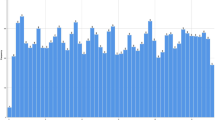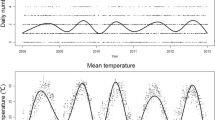Abstract
In this study, we investigated the effect of meteorological parameters on the number of renal colic patients who admitted to the emergency department regarding patients’ gender, patients’ age and season. Patients who were admitted to the emergency department with renal colic during a year were studied retrospectively. The number of patients admitted daily was divided into groups according to gender, age and seasons, and correlations between the daily meteorological parameters were examined. In our study, a total of 1890 patients were enrolled and of those 64.9 % (n = 1227) were male. The mean age of the patients was 38 ± 14.7/years (18–94). The number of patients admitted daily was 5 ± 2.9/patients (1–18). Positive correlation was found between the daily number of patients and daily maximum temperature (p < 0.001, r = 0.212), and daily minimum temperature (p = 0.003, r = 0.160) and daily temperature difference (p < 0.001, r = 0.218). Additionally, a negative correlation with the daily relative humidity (p = 0.001, r = −0.169) was detected. As a result of multivariate regression analysis, age was found to independently affect the number of RC patients admitted to the emergency department (R 2 0.0079, t −3.56, p < 0.001). Negative correlation was found between relative humidity and female patients, patients in the 30–39 years of age group, and the daily number of RC patients admitted in spring. We found positive correlation between temperature and the number of patients under the age of 39 years, but we concluded that the daily number of patients above the age of 40 years did not significantly correlate with temperature rise. In our study, we determined that meteorological parameters have an effect on renal colic and that this effect varies depending on the patients’ age, patients’ gender and season.


Similar content being viewed by others
References
Pearle MS, Calhoun EA, Curhan GC, Urologic Diseases of America Project (2005) Urologic diseases in America project: urolithiasis. J Urol 173(3):848–857. doi:10.1097/01.ju.0000152082.14384.d7
Worcester EM, Coe FL (2010) Clinical practice. Calcium kidney stones. N Engl J Med 363(10):954–963. doi:10.1056/NEJMcp1001011
Hiatt RA, Dales LG, Friedman GD, Hunkeler EM (1982) Frequency of urolithiasis in a prepaid medical care program. Am J Epidemiol 115(2):255–265
Turkcuer I, Serinken M, Karcioglu O, Zencir M, Keysan MK (2010) Hospital cost analysis of management of patients with renal colic in the emergency department. Urol Res 38(1):29–33. doi:10.1007/s00240-009-0251-z
Holdgate A, Oh CM (2005) Is there a role for antimuscarinics in renal colic? A randomized controlled trial. J Urol 174(2):572–575. doi:10.1097/01.ju.0000165337.37317.4c discussion 575
Golzari SE, Soleimanpour H, Rahmani F, Zamani Mehr N, Safari S, Heshmat Y, Ebrahimi Bakhtavar H (2014) Therapeutic approaches for renal colic in the emergency department: a review article. Anesthesiol Pain Med 4(1):e16222. doi:10.5812/aapm.16222
Holdgate A, Pollock T (2004) Systematic review of the relative efficacy of non-steroidal anti-inflammatory drugs and opioids in the treatment of acute renal colic. BMJ 328(7453):1401. doi:10.1136/bmj.38119.581991.55
Davenport K, Timoney AG, Keeley FX (2005) Conventional and alternative methods for providing analgesia in renal colic. BJU Int 95(3):297–300. doi:10.1111/j.1464-410X.2005.05286.x
Elliott JP Jr, Gordon JO, Evans JW, Platt L (1975) A stone season. A 10-year retrospective study of 768 surgical stone cases with respect to seasonal variation. J Urol 114(4):574–577
Borghi L, Guerra A, Meschi T, Briganti A, Schianchi T, Allegri F, Novarini A (1999) Relationship between supersaturation and calcium oxalate crystallization in normals and idiopathic calcium oxalate stone formers. Kidney Int 55(3):1041–1050. doi:10.1046/j.1523-1755.1999.0550031041.x
Boscolo-Berto R, Dal Moro F, Abate A, Arandjelovic G, Tosato F, Bassi P (2008) Do weather conditions influence the onset of renal colic? A novel approach to analysis. Urol Int 80(1):19–25. doi:10.1159/000111724
Chauhan V, Eskin B, Allegra JR, Cochrane DG (2004) Effect of season, age, and gender on renal colic incidence. Am J Emerg Med 22(7):560–563
Pincus S, Macbean C, Taylor D (2010) The effects of temperature, age and sex on presentations of renal colic in Melbourne, Australia. Eur J Emerg Med Off J Eur Soc Emerg Med 17(6):328–331. doi:10.1097/MEJ.0b013e32833547b7
Al-Hadramy MS (1997) Seasonal variations of urinary stone colic in Arabia. JPMA J Pak Med Assoc 47(11):281–284
Lujan M, Sanchez MT, Turo J, Pascual C, Chiva V, Martin C, Torres J (2011) Climate and epidemiological characteristics of renal colic attendances in an urban setting in Spain. Actas Urol Esp 35(8):481–486. doi:10.1016/j.acuro.2011.03.007
Freeg MA, Sreedharan J, Muttappallymyalil J, Venkatramana M, Shaafie IA, Mathew E, Sameer R (2012) A retrospective study of the seasonal pattern of urolithiasis. Saudi J Kidney Dis and Transplant Off Publ Saudi Center Organ Transplant Saudi Arab 23(6):1232–1237. doi:10.4103/1319-2442.103565
Baker PW, Coyle P, Bais R, Rofe AM (1993) Influence of season, age, and sex on renal stone formation in South Australia. Med J Aust 159(6):390–392
Ahlstrand C, Tiselius HG (1981) Renal stone disease in a Swedish district during one year. Scand J Urol Nephrol 15(2):143–146. doi:10.3109/00365598109179591
Laerum E (1983) Urolithiasis in general practice. An epidemiological study from a Norwegian district. Scand J Urol Nephrol 17(3):313–319
Al-Dabbagh TQ, Fahadi K (1977) Seasonal variations in the incidence of ureteric colic. Br J Urol 49(4):269–275
Basiri A, Moghaddam SM, Khoddam R, Nejad ST, Hakimi A (2004) Monthly variations of urinary stone colic in Iran and its relationship to the fasting month of Ramadan. JPMA J Pak Med Assoc 54(1):6–8
Cervellin G, Comelli I, Comelli D, Cortellini P, Lippi G, Meschi T, Borghi L (2011) Regional short-term climate variations influence on the number of visits for renal colic in a large urban Emergency Department: results of a 7-year survey. Intern Emerg Med 6(2):141–147. doi:10.1007/s11739-011-0518-6
Evans K, Costabile RA (2005) Time to development of symptomatic urinary calculi in a high risk environment. J Urol 173(3):858–861. doi:10.1097/01.ju.0000152578.07262.1c
Brikowski TH, Lotan Y, Pearle MS (2008) Climate-related increase in the prevalence of urolithiasis in the United States. Proc Natl Acad Sci USA 105(28):9841–9846. doi:10.1073/pnas.0709652105
Conflict of interest
The authors declare that they have no conflict of interest.
Author information
Authors and Affiliations
Corresponding author
Rights and permissions
About this article
Cite this article
Atescelik, M., Yilmaz, M., Gurger, M. et al. The effect of meteorological parameters on the number of renal colic patients. Urolithiasis 43, 331–337 (2015). https://doi.org/10.1007/s00240-015-0779-z
Received:
Accepted:
Published:
Issue Date:
DOI: https://doi.org/10.1007/s00240-015-0779-z




